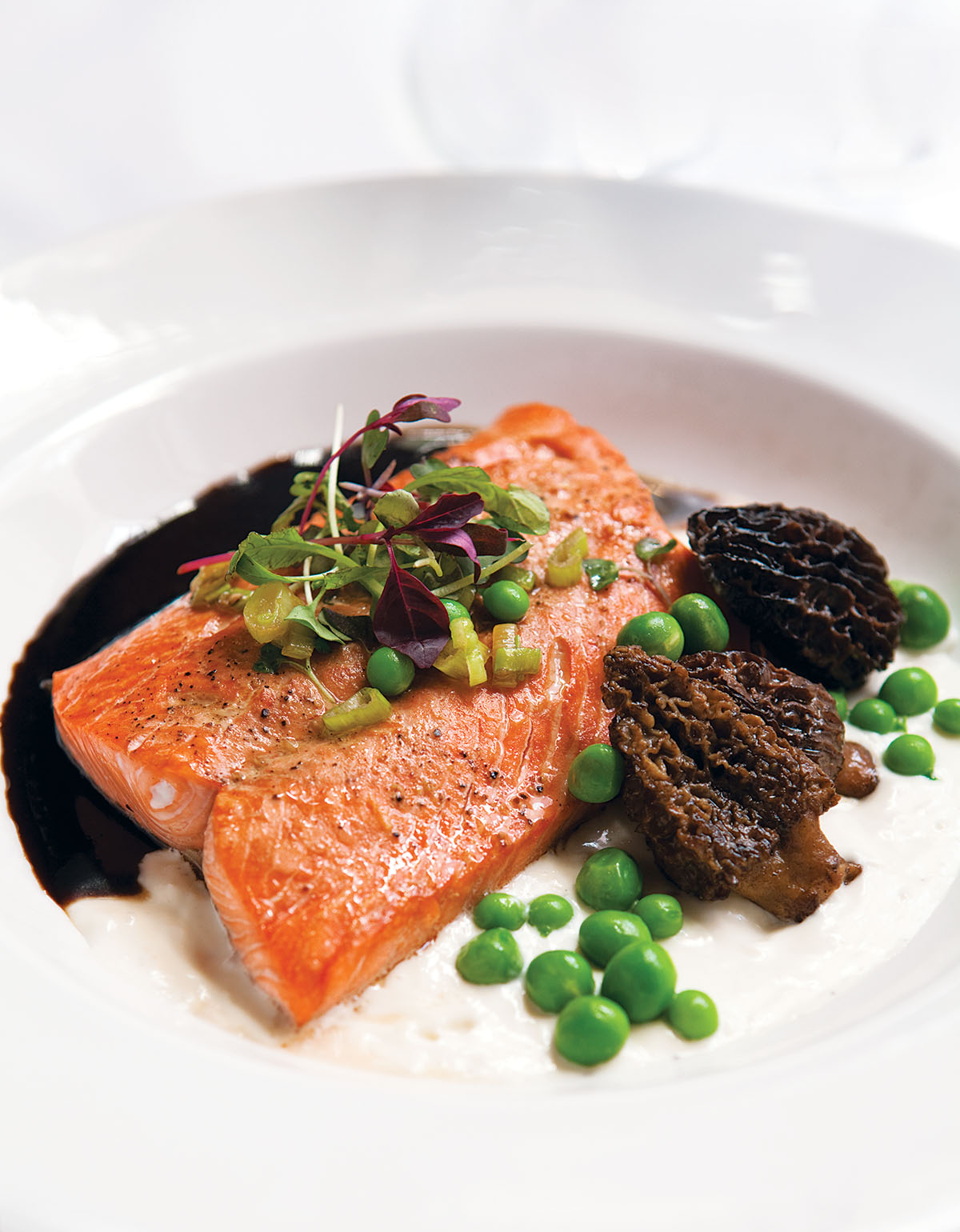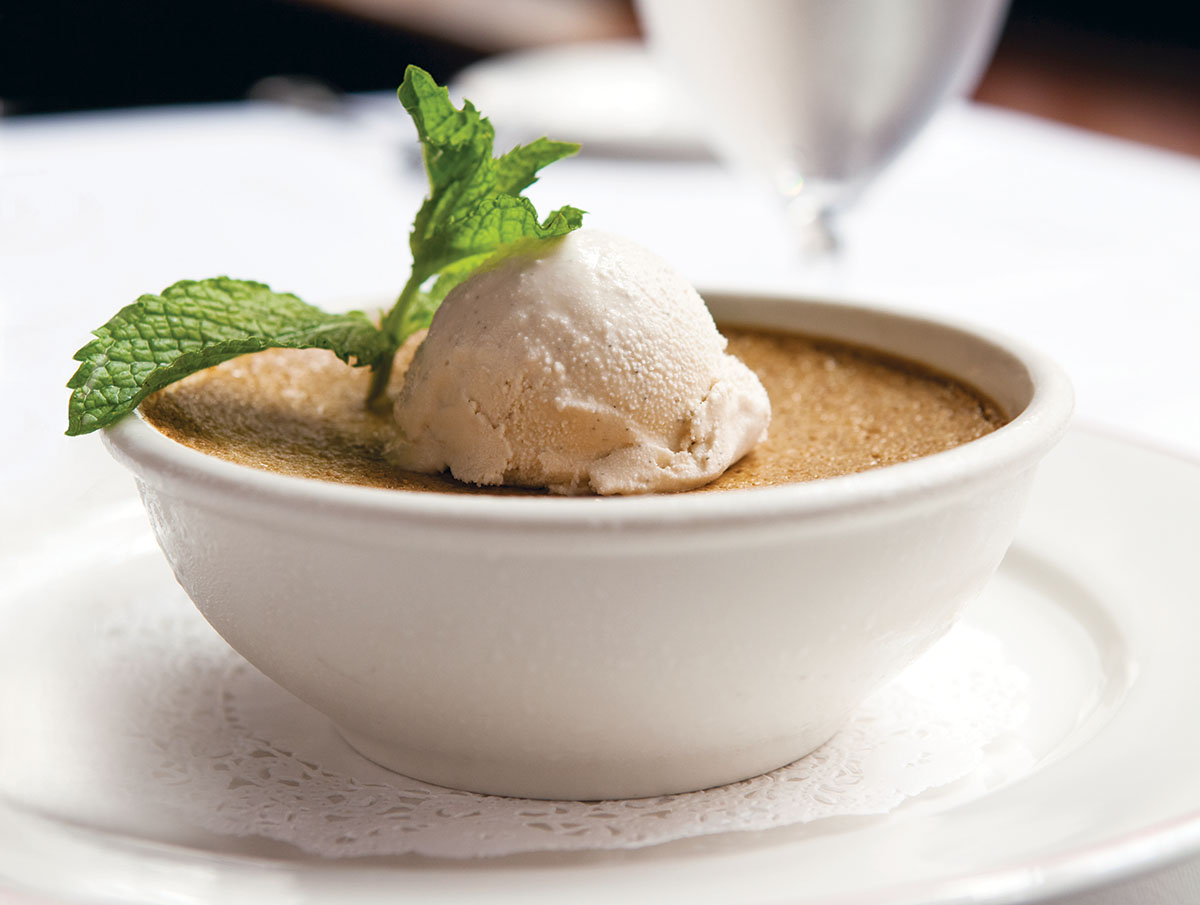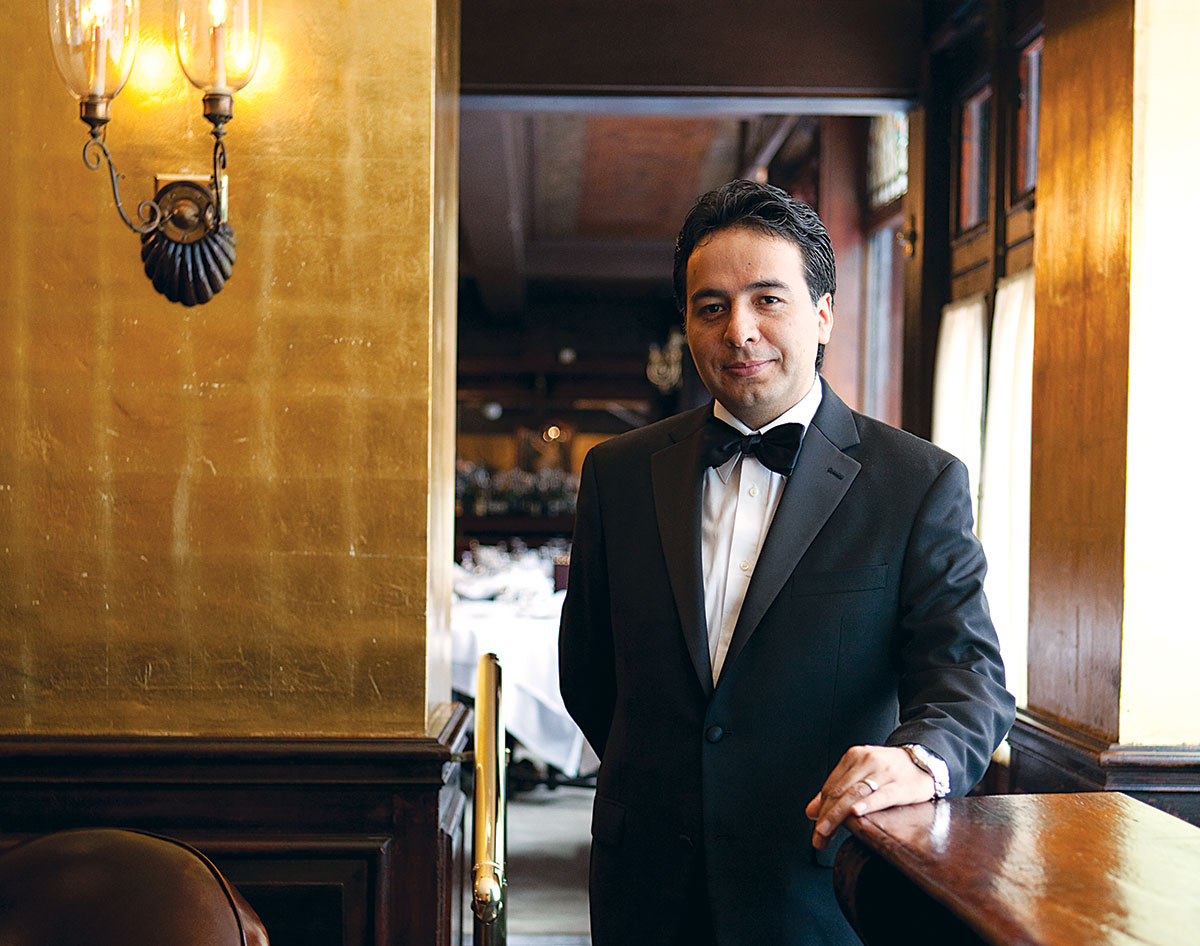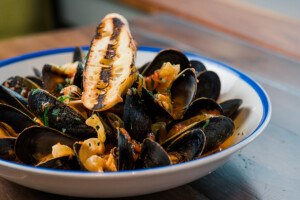Dining Out at Locke-Ober

Photograph by Keller + Keller
Wild Alaskan sockeye salmon with spring peas, morels, and balsamic cream, $33
Locke-Ober, that venerable institution, that magnificent relic of Boston as a gathering place for the great and the good (and politicians, too), is on life support. As it goes into its 144th year, it sputters along, clinging to its third, fourth, or maybe seventh in its allocation of nine lives. The question this time around is: Should this patient be allowed to live?
I didn’t think I’d ever ask that question. I cheered when chef Lydia Shire reopened Locke-Ober at the end of 2001, after an expensive restoration that burnished the brass, polished the mahogany, shined the huge silver tureens, reapplied the gold leaf, and stripped off six layers of linoleum floors. Shire put Jacky Robert, a chef who can do anything with classics, in the kitchen.
It was a joy to have the kind of 19th-century grandee’s restaurant you see only in old prints gleaming, and serving real food. Locke-Ober is as much a city landmark as the Old State House and Old City Hall. But the newfound vitality didn’t last: Shire went on to start other restaurants, and Robert opened his marvelously reliable Petit Robert bistros. After a recent three-month closure — during which the building and restaurant’s owner, David Ray, reclaimed management — the institution has once again reopened, and it has, to put it unkindly, a dead-waiters-walking feel. Maybe it’s okay that the gleam is off the gold leaf, that the ceiling is showing cracks. Maybe it’s fine that everything is back to the sort of clubby baseline of the pre-Shire days, when the place was about making deals and showing (or wanting to show) yourself as part of the establishment. It’s certainly primed for a Mad Men–inspired rediscovery, especially given a falling-facelift look that will only add to the appeal for people who wish they could smoke and drink all the time.

Photograph by Keller + Keller
Indian pudding à la mode, $10
As for eating…well, the challenge is what to do with a menu filled with indulgent classics that were once second nature to the smoking-drinking crowd. Vice? Why stop at one? Lobster floating in melted butter (the famous lobster Savannah, market price) and prime filet mignon ($38–$52) seemed less like indulgences than earned rights back then. But people don’t eat that way now — and, to his credit, Ray seems to recognize that reality in a way Shire did not. Managing director Paul Licari has added a wider variety of salads and side dishes to the menu, while roping off the classics in an easy-to-find box. And he’s promising lighter dishes and lower prices when he reopens for lunch this fall.
Locke-Ober will need those affordable options to lure in a crowd whose typical lunch date these days is an iPhone. The tabs are too high to recommend to anyone not on a limitless per diem — high enough that you expect a level of luxury beyond the high-quality ingredients, and service that isn’t distracted because there aren’t quite enough servers. (For the price, you might also want to dine in a place that doesn’t feel like the type of stuffy, tired men’s club that welcomes women and minorities only because it’s supposed to.) Not much on the menu rose above proficient club fare, and all of it seemed too expensive for what arrived.

Photograph by Keller + Keller
Prime filet mignon à la carte, $38 for 8 ounces; $52 for 12 ounces
The two exceptions were encouraging, though, for Ray’s current and future goals. One was a classic that had been freshened, and the other was from the new list of entrées — a dish much better than it sounded and better than any of the other additions. The classic was JFK lobster stew ($10 for a cup; $16 for a bowl), so named because it was a favorite of the president’s when he was still a senator. It tasted much purer and lighter than I remember it, a wonderful indulgence. The new entrée was wild Alaskan sockeye salmon with spring peas, morels, and balsamic cream ($33), which sounded dull but was the best thing I ate. The thick slab of fish really looked like it was worth the money — as, say, the 10 ounces of swordfish with underflavored shrimp-and-fava risotto ($34) did not. The salmon was in a soy–green onion glaze that so enhanced the flavor I decided I’d never had better outside Alaska. Crucially, the guest who ordered it asked for it rare, and there were so many morels on the plate that he could offer them around. I stress their abundance because almost every other entrée, particularly the traditional and à la carte selections, seemed devoid of vegetables or even garnish. This is, admittedly, a typical steakhouse style, but it felt stingy when the meat and fish didn’t merit the focus or the price (and were uniformly oversalted and overpeppered).
What made me breathe a sigh of relief when the salmon arrived was that it showed that the chef de cuisine, David Artiano, has some imagination and skill beyond the standards. Unfortunately, the Dover sole, which Licari imports from the Netherlands, was mushy and almost flavorless — a disappointment, because I typically love its meaty texture and authoritative flavor, and because it cost $42. The salads are a welcome menu addition, but overall they were wan, tea-roomy, and overpriced: Locke-Ober salad ($11) with candied walnuts, sun-dried tomatoes, and deviled egg; caesar ($11) that was surprisingly garlicky; iceberg ($12) with green goddess and pork cracklings that were tiny, tough, and reminded us all of Bac-Os. Clams casino ($13) tasted of nothing but red pepper and heavily smoked bacon. Fried soft-shell crabs (market price) were more in the direction Licari said he plans to go: simply cooked, based on what’s fresh, and available in different sizes.
Flexibility, simplicity, and better value are what I hope to see in the future, given the expectations of people who go to Locke-Ober, and the inability of many to pay $46 for a 14-ounce prime New York strip. And given what seems to be the just-serviceable capability of the kitchen, absent that really good salmon. A scallop-and-oyster pasta ($34) with tough, clumped-together pappardelle was a dismal dish, though the scallops were fine; soy-roasted duck ($32) was dry, stringy, and tough.

Photograph by Keller + Keller
Locke-Ober’s crisply outfitted hosts and waitstaff recall a bygone era.
Those two dishes remained almost uneaten, but we did clean the two least-expensive entrée plates — broiled Boston scrod ($26), expertly and crisply breaded with lovely texture and flavor; and calf’s liver with onions and bacon ($25), which made no secret of being liver and had nicely caramelized onions. Both of those favorites are strongly associated with Locke-Ober, so the vital signs are in good shape. So are two of the classic desserts: almond macaroons ($6), from the same East Boston baker that has provided them for decades, and the light, custardy Indian pudding à la mode ($10). Yet the baked Alaska ($10) featured undercooked meringue and the crème brûlée ($10) was underbrowned.
More staff members, lower prices — yes, I know they don’t go together — and a way to encourage diversity in the patrons: That’s my wish list for this listless sleeping beauty. I don’t have a crystal ball, but maybe its future won’t be white-haired, WASPy, or even white at all.
Locke-Ober, 3 Winter Place, Boston, 617-542-1340, lockeober.com.


